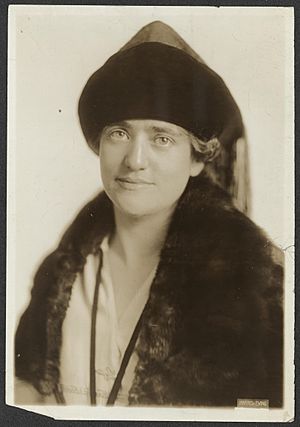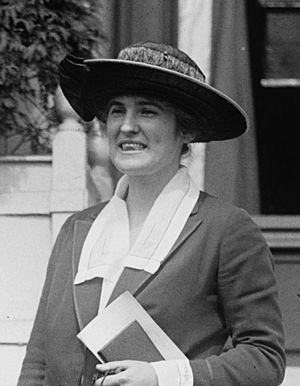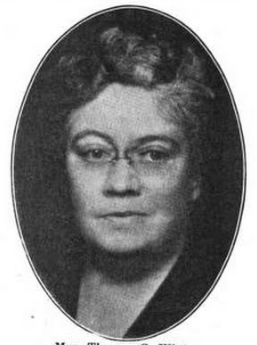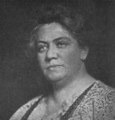Minnesota Woman Suffrage Memorial facts for kids
Quick facts for kids Minnesota Woman Suffrage Memorial |
|
|---|---|
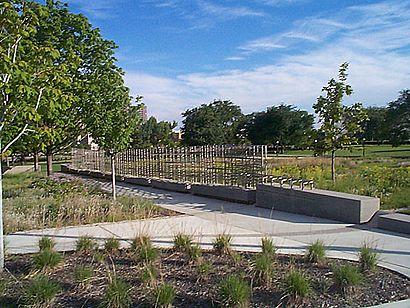 |
|
| Artist | Raveevarn Choksombatchai and Ralph Nelson |
| Year | 2000 |
| Type | Steel |
| Location | Saint Paul, Minnesota |
| 44°57′12″N 93°06′03″W / 44.95332°N 93.10086°W | |
The Minnesota Woman Suffrage Memorial is a special monument located at the Minnesota State Capitol in Saint Paul, Minnesota. It honors 25 amazing women who played a big part in the Minnesota Woman Suffrage Association (MWSA). This group worked hard to get women the right to vote.
Contents
- History of the Memorial
- Amazing Women Honored
- Harriet Bishop: Teacher and Activist
- Fanny Fligelman Brin: Champion for Rights
- Myrtle Cain: Early Woman Legislator
- Mary Jackman Colburn: A Voice for Equality
- Sarah Tarleton Colvin: Nurse and Protester
- Gratia Countryman: Library Leader
- Nellie Griswold Francis: Civil Rights Pioneer
- Elizabeth Hunt Harrison: Dedicated Suffragist
- Ethel Edgerton Hurd: Doctor and Organizer
- Nanny Mattson Jaeger: Club President
- Bertha Berglin Moller: White House Protester
- Julia Bullard Nelson: MWSA Founder
- Emily Gilman Noyes: St. Paul Supporter
- Anna Dickie Olesen: First Woman Senator Candidate
- Mabeth Hurd Paige: Lawyer and Legislator
- Martha Rogers Ripley: Doctor and Hospital Founder
- Maria Sanford: Inspiring Professor
- Josephine Schain: Girl Scouts and UN Leader
- Josephine Sarles Simpson: Powerful Speaker
- Sarah Burger Stearns: First MWSA President
- Maud Conkey Stockwell: Petition Organizer
- Jane Grey Swisshelm: Newspaper Editor
- Clara Hampson Ueland: Leader During Ratification
- Marguerite Milton Wells: National President
- Alice Ames Winter: Club Founder and President
- Images for kids
History of the Memorial
The MWSA led the effort to get the state of Minnesota to approve the Nineteenth Amendment to the United States Constitution. This important amendment gave women across the United States the right to vote. Minnesota was the 15th state to approve it, which happened in 1919.
The idea for this memorial came from members of the Minnesota League of Women Voters. They held a contest to find the best design. Raveevarn Choksombatchai and Ralph Nelson won with their idea, chosen from 16 different designs. In 1996, the state government agreed to provide money to build the memorial.
Construction began on August 26, 1998. This date was special because it was 75 years after the 19th Amendment was approved. The memorial officially opened on August 26, 2000, with Lt. Gov. Mae Schunk leading the ceremony.
The memorial includes a garden called Garden of Time: Landscape of Change. It has aluminum signs that tell the story of the women's right to vote movement in the U.S. A special structure, like a frame, lists the names of 25 leaders from Minnesota who fought for this cause. In 2004, the memorial was updated by Roger Grothe.
Amazing Women Honored
The memorial celebrates many brave women who worked for women's rights and other important causes. Here are some of them:
Harriet Bishop: Teacher and Activist
Harriet Bishop (1818–1883) came to Minnesota to teach. She started the very first public school and Sunday school in the Minnesota area. She was active in both the temperance movement, which worked against alcohol, and the women's right to vote movement.
Fanny Fligelman Brin: Champion for Rights
Fanny Brin (1884–1961) was a strong supporter of women's rights, Jewish welfare, and world peace. She led the National Council of Jewish Women from 1932 to 1938. Eleanor Roosevelt even asked her to join a national committee to help people during the Great Depression.
Myrtle Cain: Early Woman Legislator
Myrtle Cain (1894–1980) was the president of the Women's Trade Union of Minneapolis. She was also one of the first women to serve in the Minnesota House of Representatives, helping to make laws for the state.
Mary Jackman Colburn: A Voice for Equality
Mary Colburn (1811–1901) was born in Massachusetts and became a doctor in the 1840s. She moved to Minnesota and continued her medical practice.
Mary became very involved in the movement for women's right to vote. In 1858, she gave what is believed to be the first public talk on this topic in Minnesota. It was called "Rights and Wrongs of Woman."
In 1867, Mary Colburn and Sarah Burger Stearns, along with other supporters, asked the Minnesota State Legislature to change the state's constitution. They wanted to remove the word "male" from the part that said who could vote. They were given a chance to speak, but no changes were made at that time. Colburn was also one of the people who helped start the MWSA.
Sarah Tarleton Colvin: Nurse and Protester
Sarah Colvin (1865–1949) was a nurse who served with the Red Cross during World War I. She led the Minnesota chapter of the National Woman's Party. She was even arrested during protests in 1919 and went on a hunger strike in jail.
Gratia Countryman: Library Leader
Gratia Countryman (1866–1953) was a librarian. She led the Minneapolis Public Library from 1904 to 1936. She also led the Minnesota Library Association for a time.
Nellie Griswold Francis: Civil Rights Pioneer
Nellie Francis (1874–1969) was a suffragist and civil rights activist. She was the first president of the Everywoman Suffrage Club, an African-American group that supported women's right to vote.
Elizabeth Hunt Harrison: Dedicated Suffragist
Elizabeth Harrison (1848–1931) was part of many women's right to vote organizations, including the MWSA. In 1930, she was one of six Minnesota women recognized by the National League of Women Voters for her contributions.
Ethel Edgerton Hurd: Doctor and Organizer
Ethel Hurd (1845–1929) earned a medical degree in 1897 when she was 52 years old. She practiced medicine with her daughter. She helped start the Medical Women's Club of Minneapolis and the Minnesota Scandinavian Woman Suffrage Association. She also wrote a book called Woman Suffrage in Minnesota.
Nanny Mattson Jaeger: Club President
Nanny Jaeger (1859–1938) was the president of the Political Equality Club of Minneapolis. She also led the Minnesota Scandinavian Woman Suffrage Association.
Bertha Berglin Moller: White House Protester
Bertha Moller (1888–unknown) was the secretary of the Minnesota branch of the National Woman's Party. She protested at the White House and the Capitol in Washington D.C. She was arrested 11 times and even went on a hunger strike in jail.
Julia Bullard Nelson: MWSA Founder
Julia Nelson (1842–1914) helped start the MWSA and served as its president from 1890 to 1896. She was also a vice-president of the state Woman's Christian Temperance Union.
Emily Gilman Noyes: St. Paul Supporter
Emily Noyes (1854–1930) was an important supporter of women's right to vote from St. Paul. She helped create the Woman's Welfare League in 1912 and was its first president. She was also a vice-president of the MWSA.
Anna Dickie Olesen: First Woman Senator Candidate
Anna Olesen (1885–1971) was the first woman nominated by a major political party to run for U.S. Senator.
Mabeth Hurd Paige: Lawyer and Legislator
Mabeth Paige (1870–1944) earned a law degree from the University of Minnesota. She started the Minneapolis chapter of the Urban League and was one of the first women in the Minnesota House of Representatives.
Martha Rogers Ripley: Doctor and Hospital Founder
Martha Ripley (1843–1914) was a doctor. She founded the Maternity Hospital in Minneapolis. She also served as president of the MWSA from 1883 to 1889.
Maria Sanford: Inspiring Professor
Maria Sanford (1836–1920) was a history professor at Swarthmore College and the University of Minnesota. She joined the women's right to vote movement later in her life.
Josephine Schain: Girl Scouts and UN Leader
Josephine Schain (1886–1949) graduated from the University of Minnesota. She worked in social services. She was the national director of the Girl Scouts from 1930 to 1935. In 1943, she was the first woman to officially represent the U.S. at a United Nations Conference. She was also a consultant when the United Nations was formed in 1945.
Josephine Sarles Simpson: Powerful Speaker
Josephine Simpson (1862–1948) was a founding member of the Woman's Club of Minneapolis. She was known as a great speaker for the cause of women's right to vote. She served on the board of directors for the National American Woman Suffrage Association.
Sarah Burger Stearns: First MWSA President
Sarah Stearns (1836–1904) helped start the MWSA and was its very first president from 1881 to 1883.
Maud Conkey Stockwell: Petition Organizer
Maud Stockwell (1863–1958) was president of the MWSA from 1900 to 1910. She started several clubs that supported women's right to vote. She even carried Minnesota's 20,000 signatures supporting suffrage to the capitol in Washington D.C.
Jane Grey Swisshelm: Newspaper Editor
Jane Swisshelm (1815–1884) was a newspaper editor in St. Cloud. She wrote about ending slavery, women's rights, and the right to vote.
Clara Hampson Ueland: Leader During Ratification
Clara Ueland (1860–1927) was the president of the MWSA when the 19th Amendment was approved. She was also the first president of the Minnesota League of Women Voters.
Marguerite Milton Wells: National President
Marguerite Wells (1872–1959) helped organize the petition drive for the MWSA. This effort led to all of Minnesota's representatives supporting the 19th Amendment. In 1919, she became the first vice-president of the Minnesota League of Women Voters, and later its national president.
Alice Ames Winter: Club Founder and President
Alice Winter was one of the people who started the Minneapolis Woman's Club and served as its president. After World War I, she became president of the General Federation of Women's Clubs.
Images for kids


